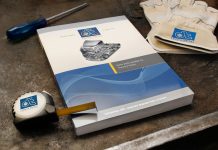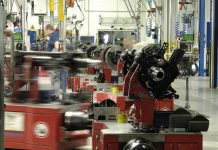Substantially more fuel-efficient, quieter, more powerful and more comfortable. DAF Components introduces significant innovations at Busworld 2017 in Kortrijk, Belgium – downspeeding engines and accompanying axles for buses and coaches. The newly improved PACCAR MX-11 and MX-13 engines are incredibly quiet, providing optimum return at extra-low engine speeds. DAF is also introducing newly developed, extremely fast DAF rear axles, which – in combination with optimised transmissions – delivers exceptionally low fuel consumption and unprecedented travel comfort.
Downspeeding
The starting point in the development of the new PACCAR MX-11 and MX-13 engines was to reduce speeds (downspeeding) in order to fully optimise fuel consumption. The new generation PACCAR MX-11 and MX-13 deliver their maximum torque from 900 rpm, without compromising performance. This means that it is possible for both the MX-11 and MX-13 to turn at around 1,050 rpm at cruising speed.
High torque
To ensure plenty of traction and a high level of driving comfort, even at the new, lower engine speeds, the torque on all new engines has been increased by 50 Nm to 200 Nm (depending on the engine type). The rating of almost every engine has also been increased by 10 kW/14 hp to 15 kW/20 hp.
Innovations
PACCAR MX-11 and MX-13 engines have been enhanced further to enable downspeeding. For both engines, components including engine block, cooling, air inlet, bearings for the crankshaft and pistons, have all been adapted. The combustion process has also been enhanced and the compression ratio increased.
In addition, new and even more efficient turbos have been used, meaning that the engine delivers even more torque at low engine speeds while providing more efficient combustion. With a view to maximum efficiency, DAF is using a continuously variable oil pump, as well as a completely new oil module with reduced pressure losses. This newly-developed pump ensures that the oil pressure is always precisely aligned with the engine requirements, saving energy and thus fuel. The same principle also applies to the new continuous variable cooling water and steering pumps, which also help to reduce fuel consumption.
Increased rating and torque
The new PACCAR MX-11 engine comes with ratings of 220 kW/299 hp, 251 kW/341 hp, 270 kW/367 hp, 300 kW/408 hp and 330 kW/449 hp. The engine torque is 1,350 Nm and 1,500 Nm for the two lightest power trains. The most powerful MX-11 engine variants deliver a torque of 1,900, 2,100 and 2,300 Nm respectively.
The ratings for the redesigned PACCAR MX-13 are 315 kW/428 hp, 355kW/483 hp and 390 kW/530 hp, with torque set at 2,300 Nm, 2,500 Nm and 2,600 Nm respectively.
DAF engine brake sets benchmark
The drive torque and rating of the engine are not the only aspects that are increased. The already leading MX engine brake on both the PACCAR MX-11 and the MX-13 has become even more powerful thanks to innovations on the valve train, including an adjustment to the cam profile. Just like the MX-11, this means the MX-13 now has an engine brake with ‘single valve activation’, which delivers more braking performance at a lower speed. It goes without saying that both engine brakes offer maximum performance over an extremely wide range of engine speeds. This not only limits wear on the brakes, but also delivers a higher average speed.

The braking power of the PACCAR MX-11 is increased by 10% to 340 kW (463 hp). And even more important, the braking torque in the range between 1,200 and 1,500 rpm is increased by 20%. Thanks to these performance levels, DAF Components has set a new benchmark in the 11-litre segment.
The engine brake on the MX-13 already delivered unrivalled power at low engine speeds and this has now been further enhanced. Between 1,000 and 1,450 rpm, the new MX-13 engine brake delivers 20% more braking power, peaking at almost 30% at around 1,200 rpm. The maximum braking power equates to 360 kW (490 hp) from 2,100 rpm.

EcoMode
For maximum fuel efficiency, the MX-11 and MX-13 engines can—in close consultation with the bus or coach builder—also be supplied with an Eco Fuel Mode. This engine setting is primarily aimed at achieving the lowest possible fuel consumption. For example, Eco Fuel Mode ensures that gear changes are made earlier and that the engine responds more moderately to changes in the position of the accelerator pedal. Eco Performance Mode on the other hand is designed for higher performance, making the engine more alert by delaying gear changes slightly and responding more powerfully.
Newly developed cruise control
The operation of the cruise control system on sloping terrain is also new. Here, Predictive Cruise Control (PCC) not only ensures gentle torque build-up, but also guarantees a faster torque build-up on steep inclines, to keep the road-speed as high as possible without compromising fuel efficiency.
Eco Roll and Predictive Cruise Control have also been optimised. In the past, the truck would simply have decelerated just before the top of an incline. Now, the transmission is placed in neutral whenever the mass and speed of the vehicle are sufficient to push it over the incline with the help of kinetic energy. This significantly increases the rolling distances of the bus or coach and, on long routes, can actually more than double the EcoRoll share.
Enhanced rear axles
The layout of the complete power train is important for optimum vehicle performance and efficiency. For this reason, not only the engine has been fully enhanced, but—as part of DAF Transport Efficiency—so has the rear axle. This serves a dual purpose; to facilitate downspeeding and thus maximise efficiency and also to improve passenger comfort. The weight of the rear axle has also been reduced even more.
The efficiency of the rear axle has been increased; not only by using new tooth profiles, but also by applying a new production process. This has maximised the accuracy of the gear wheel geometry, allowing friction between the individual gear wheels as well as the noise level to be minimised. DAF also uses an oil with a lower viscosity for both rear axles to reduce friction in the differential.
Finally, rear axles benefit from newly-developed low-friction wheel bearings, which also deliver lower fuel consumption.
Sustainable fuels for a lower CO2 footprint
Sustainable fuels that ensure a lower CO2 footprint are becoming available in more and more locations. That is why DAF has ensured its PACCAR MX engines can be driven on HVO (the CO2 saving is 80%), BTL (80%) and GTL (5%). PACCAR MX engines can be filled with these paraffin diesels in addition to ordinary diesels, while still maintaining service intervals of up to 200,000 kilometres.
DAF Components
For decades, DAF has held a prominent position internationally for buses and coaches as a key partner of independent coach and bus manufacturers. DAF Components provides a complete range of Euro 6 engines; the PACCAR MX-11 and MX-13, including rear axle. All PACCAR engines distinguish themselves by low fuel consumption, optimum reliability and long service intervals for the highest vehicle availability and the maximum yield per kilometre. The same applies to the popular 9.2-litre PACCAR PR and 12.9-litre PACCAR MX engines, which are supplied for Euro 3, Euro 4 and Euro 5 emission standards.
LF chassis module for compact buses
The DAF Components range also includes the chassis from the DAF LF distribution truck, which forms an ideal basis for 30- to 40-seat PSVs. DAF supplies this chassis with a wheel base of 3.05 to 6.70 metres and with 4.5-litre PACCAR PX-5 four-cylinder and 6.7-litre PACCAR PX-7 six-cylinder Euro 6 engines – including ratings of 112 kW/152 hp to 239 kW/320 hp. The DAF LF chassis module is ideal for manufacturing a wide range of vehicles, ranging from compact midi buses to luxurious VIP coaches.

Full service for optimum efficiency
For optimum efficiency, it is important that a bus or coach is kept on the road as much as possible. Operators of buses or coaches featuring a PACCAR engine can call on the assistance of more than 1,000 DAF service points located across Europe and beyond, of which 200 are specially appointed as ‘DAF Coach & Bus dealers’. These dealers are located along major routes for passenger travel and are fully equipped to provide services for systems that are specific to buses and coaches. DAF’s International Coach Service is also ready to provide its services 24 hours a day, and DAF dealers offer repair and maintenance contracts for maximum reassurance before the journey commences.























